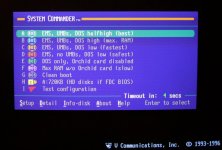CONFIG.SYS notes for EMS and/or UMBs on ORCHID RAMQuest XT/AT card. Moved out of actual CONFIG.SYS files since there are several of them and this simplifies matters considerably.
For EMS it's pretty straightforward using the Orchid MM.SYS driver. For UMBs you also need some extra files from QRAM 2.02 and QEMM 7.04.
DOSDATA from QEMM 7.04 must be the first active line in CONFIG.SYS, but ONLY if you want to load all of DOS high. If you're loading only half of it high (e.g. files, buffers, etc.) or none at all, then don't use this.
device=c:\umbs\dosdata.sys
Now for the Orchid RAMQuest XT/AT card's driver, which can be configured to provide EMS and UMBs or plain old EMS. Remove the /Z switch to thoroughly test RAM (boot takes much longer). Use the /E switch (only standard EMS pages available) to be completely strict about EMS provision, but that disables the option to use UMBs. It's 'safest' but not necessarily that useful. No idea why SETRAM added /X=E000H-EFFFH (on the MTC Turbo XT) because as far as I can tell there's nothing there. Anyway, here's the original line, plus /E for extra stability and no UMBs:
DEVICE=c:\orchid\MM.sys /o=05H /X=E000H-EFFFH /F /Z /E
If you want UMBs instead, there are two choices with QRAM 2.02. Move page frame for 128KB contiguous UMB (depending on ROM placements):
DEVICE=c:\orchid\MM.SYS /o=05h /S=E000H /F /Z
But if you only need 64KB UMB you can save 64KB of EMS like this:
DEVICE=c:\orchid\MM.SYS /o=05h /S=D000H /X=E000H-EFFFH /F /Z
Note that you can reduce MM.SYS's RAM requirements by 6.4KB by setting /H=63 and /C=127 (Handles and Contexts respectively) compared with the default. No need to go lower, and probably unwise anyway (read my notes elsewhere). Unless you have a reason not to, this is probably worth doing. Use Norton Sysinfo to see how many handles are actually in use at any time, and increase the numbers if you run out. Changing /D (context depth) appears to have no effect, so leave it at the default of 5.
Now get QRAM.SYS from QRAM 2.02 to handle the UMBs. The NOXMS flag prevents complaints from TDSK about invalid XMS. Since there is no XMS on an 8088/V20, it's probably wise to include it here.
device=c:\umbs\qram.sys NOXMS
DOS-UP.SYS is from QEMM 7.04 but works fine here. But if you want more UMBs then REM this out. In some circumstances that might be preferable because disk access - including RAM disks - seems to work faster if DOS itself is kept low. But files, buffers, etc. are OK in mapped UMBs: there's no performance difference.
device=c:\umbs\dos-up.sys
MM.SYS uses some file handles, so I've increased them here. 32 is probably sensible, maybe even 35. However, if you're loading them high later (e.g. DOS low but DOS segments high, the 'halfhigh' configuration) then set the minimum allowed here and use files.com, buffers.com, fcbs.com and lastrdriv.com from QRAM/QEMM to make up the difference in autoexec.bat. So here are the minimum ones, with the real ones in brackets:
FILES=8 (or 32)
BUFFERS=1 (or 25, the ideal number for performance)
FCBS=1,0 (or 4,0)
We'll probably reserve H, I and J for Psion connected disks, so will need at least J here, but if loading lastdriv.com later we can have C for now. Be sure to set this to the highest physical drive even so - don't set it to C if you also have D and E as hard drives, for example, or they may not be accessible.
LASTDRIV=C (or J if that's the last, including RAM disks)
Remove the next line if you get game lock-ups, but I think it's fine:
STACKS=0,0
CF-IDE may mess up floppy changeline, so tell system that installed drives do NOT have changeline, so it re-reads them each time. You'll need to change the values here if the drives change: 7=1.44MB, 1=1.2MB, 0=360KB. The lack of a /C switch denotes the lack of changeline.
drivparm /d:0 /f:7
drivparm /d:1 /f:1
NB. LOADHI.SYS and LOADHI.COM are from QEMM 7.04. Only use them if there are UMBs available, otherwise trim the statements accordingly.
The next line is required for running Windows 2.03 on DOS 5.00. It works with UMBs and DOS 'halfhigh' but not if DOS is all high (i.e. max. RAM), so probably don't bother with it in that config unless you have other programs also depending on SETVER. And probably warn in whatever batch file you're using for Windows that it won't work in that mode.
device=c:\umbs\loadhi.sys c:\dos\setver.exe
2M-XBIOS.EXE is from 2M and is a BIOS to allow high-density drive access via a 16-bit ISA adapter in an 8-bit slot. The example here is for 1.44MB and 1.2MB floppy drives. BUT loading this high into UMBs swaps the drive types around, so A: becomes 1.2MB and B: becomes 1.44MB! So need to swap them around if loaded high. I've no idea why this works. Run the program to see drive type numbers.
device=c:\umbs\loadhi.sys c:\2m\2m-xbios.exe a:4 b:2 (or a:2 b:4, for example)
RAM drive in EMS. SRDISK is the fastest I've found and seems fine loaded high: there's no apparent performance impact.
device=c:\umbs\loadhi.sys c:\srdisk\srdems.sys
And finally something for the country settings:
country=044,437,c:\dos\country.sys
Add anything else you need, of course.

